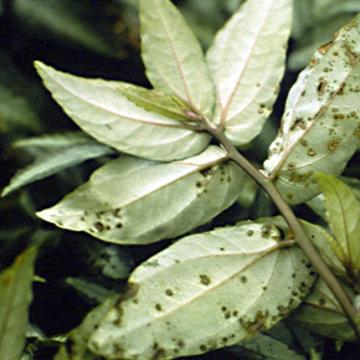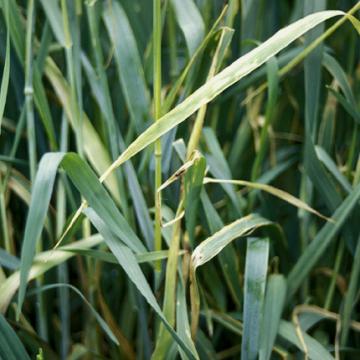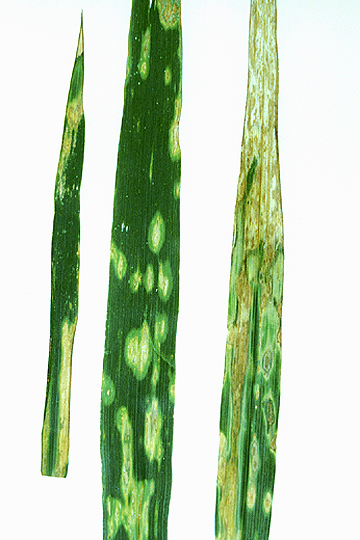DISEASE: Bacterial leaf spot
HOST: Pellionia
Leaves with dry, irregularly shaped lesions with corky, raised borders on upper surface.

Bacterial leaf spot | Pellionia
DISEASE: Bacterial leaf spot
HOST: Pellionia (Pellionia sp.)
PATHOGEN: Xanthomonas campestris
SOURCE: A. Chase
DISEASE: Bacterial leaf spot
HOST: Pellionia
Leaf lesions are irregular, corky, and slightly raised on lower leaf surfaces. Lesions may fall out, leaving a shot-hole appearance.
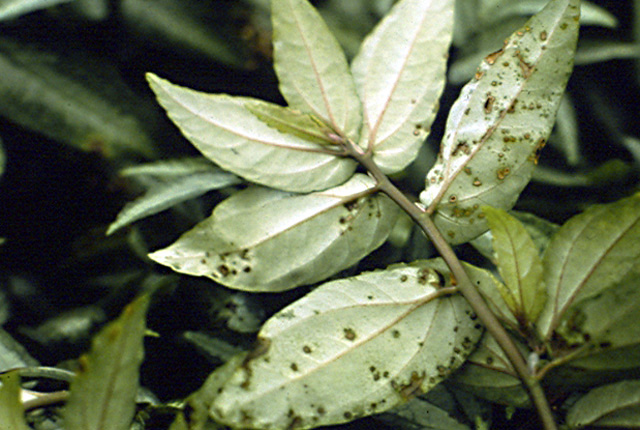
Bacterial leaf spot | Pellionia
DISEASE: Bacterial leaf spot
HOST: Pellionia (Pellionia sp.)
PATHOGEN: Xanthomonas campestris
SOURCE: H. Schwartz
DISEASE: Bacterial leaf streak
HOST: Oat
Leaf with long, dark red streaks.

Bacterial leaf streak | Oat
DISEASE: Bacterial leaf streak
HOST: Oat (Avena sativa)
PATHOGEN: Xanthomonas translucens pv. cerealis
SOURCE: L. Claflin
DISEASE: Bacterial stripe (Blight)
HOST: Oat
Leaves with irregular necrotic spots and elongated stripes that are light tan in the center. Symptoms begin as water-soaked lesions.
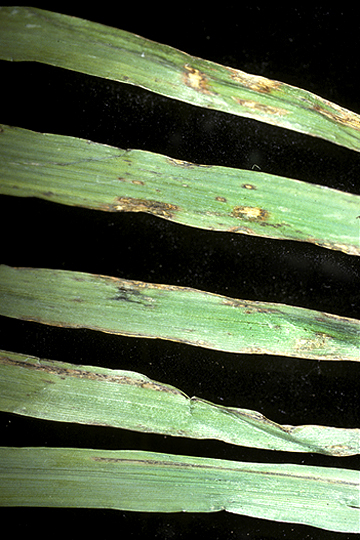
Bacterial stripe (Blight) | Oat
DISEASE: Bacterial stripe (Blight)
HOST: Oat (Avena sativa)
PATHOGEN: Pseudomonas syringae pv. striafaciens
SOURCE: S. Thomson
DISEASE: Fire blight
HOST: Pluot
Fire blight cankers on major limb. Pluot is an interspecific hybrid of plum and apricot.

Fire blight | Pluot
DISEASE: Fire blight
HOST: Pluot (Prunus hybrid 'Dandy Dapple')
PATHOGEN: Erwinia amylovora
SOURCE: S. Mohan
DISEASE: Fire blight
HOST: Pluot
Dead shoot, the result of systemic infection.

Fire blight | Pluot
DISEASE: Fire blight
HOST: Pluot (Prunus hybrid 'Dandy Dapple')
PATHOGEN: Erwinia amylovora
SOURCE: S. Mohan
DISEASE: Fire blight
HOST: Pluot
Typical symptoms of fire blight-infected shoot.

Fire blight | Pluot
DISEASE: Fire blight
HOST: Pluot (Prunus hybrid 'Dandy Dapple')
PATHOGEN: Erwinia amylovora
SOURCE: S. Mohan
DISEASE: Halo blight
HOST: Oat
Oat leaves with oval lesions that darken in time and have distinctive yellow halos.

Halo blight | Oat
DISEASE: Halo blight
HOST: Oat (Avena sativa)
PATHOGEN: Pseudomonas syringae pv. coronafaciens
SOURCE: N. Schaad



